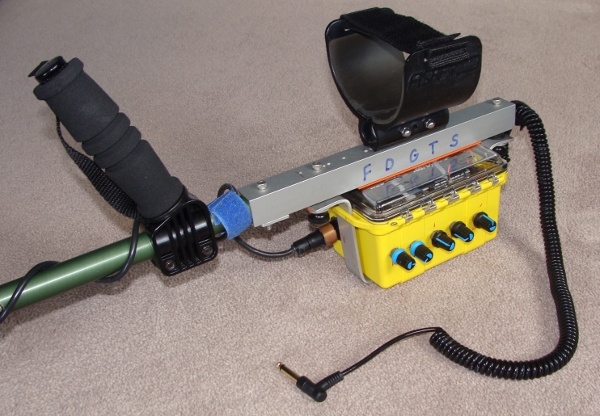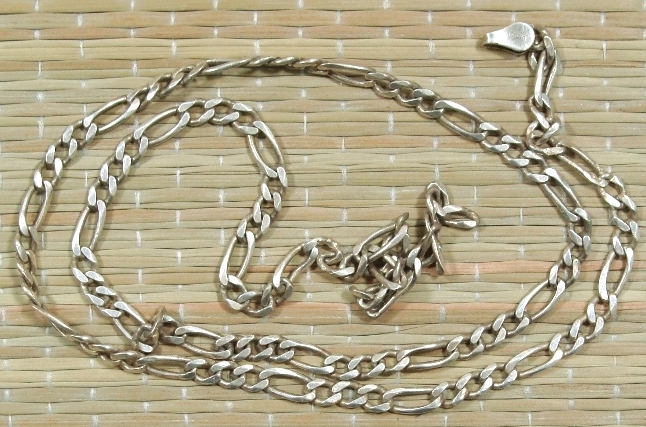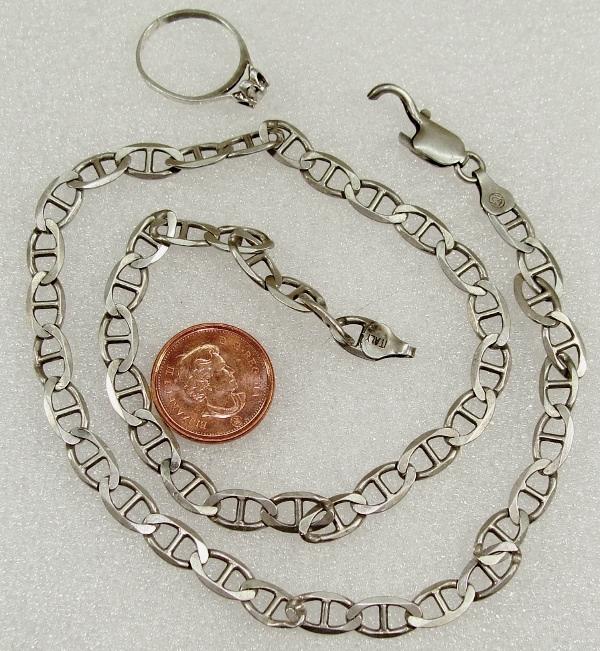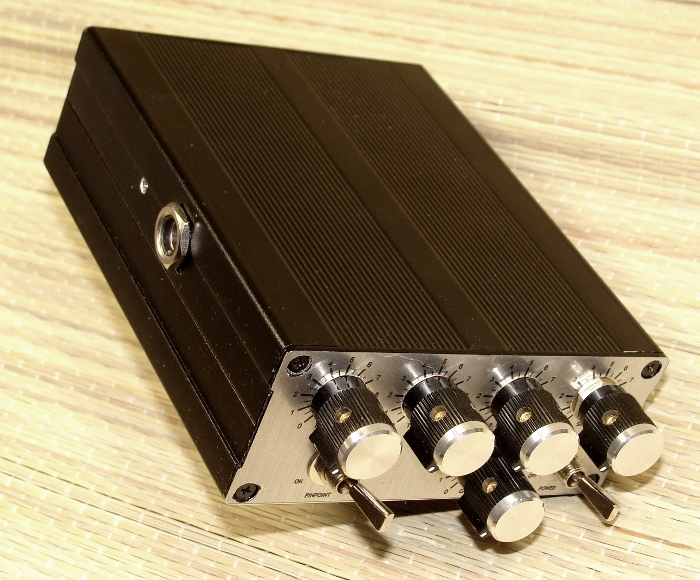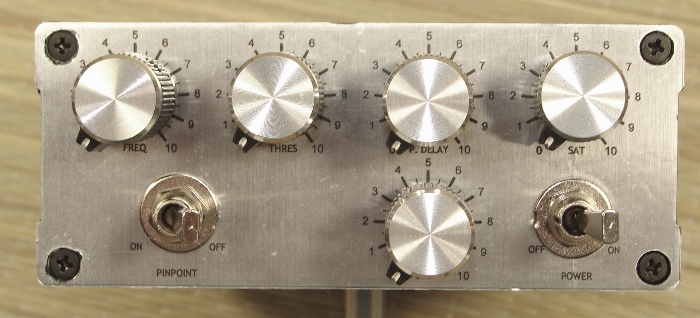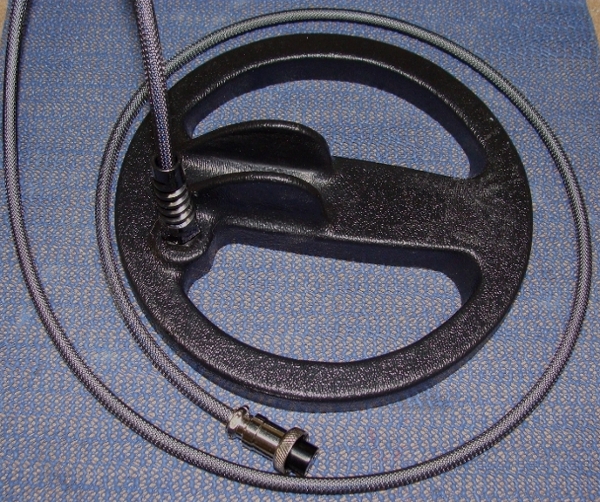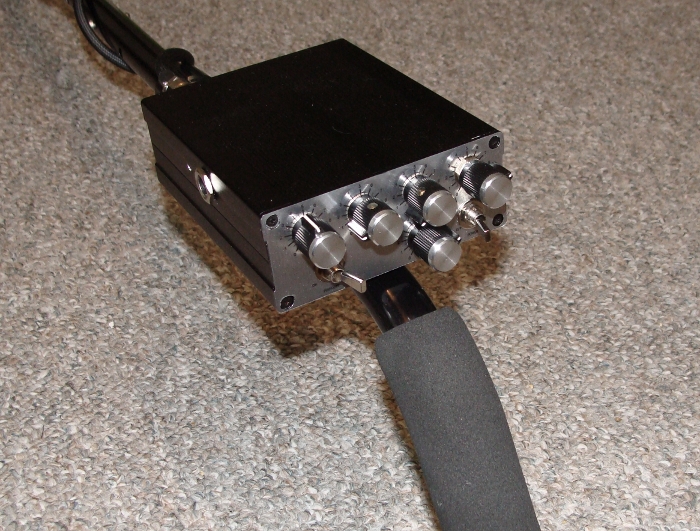PROJECTS
PI METAL DETECTOR 2012
I like water hunting for gold and silver jewelry, finding coins is an added bonus. I currently own a Detectorpro Wader VLF unit. The VLF units have discrimination and work great around trashy areas. But, don't always have the ability to detect through heavy mineralization. Which also results in lost depth and missing deeper potential good targets. PI (Pulse Induction) detectors would make an excellent choice for extreme depth and plowing through mineralization. Since there is really no discrimination control, PI's work best in areas with the least amount of small trash. When water hunting most of the trash will be found closer to shore. Leaving heavier gold, silver and coins in deeper water and possibly deep in the sand. This is where the PI will shine.
The PI that I am building is really nice, plenty of controls to fine tune the machine for optimum results. After a lot of hard work, one PCB was powered up to a temporary search coil. No internal adjustments were made. External controls were adjusted to get a sense of how it might perform. Pleased to say, it works! Will pick up in air a man's 14k wedding band at 11" and a small 10k ladies ring at 9". A 3 grain gold nugget can be picked up 2-3" with the smaller coil. Like most PI, do not have a discrimination control feature...You can hear some differences in a target audio response between gold rings and coins to iron or other trash items.
Two search coils, a 10.5" for water and relic hunting and a 7" for prospecting, etc. have been made. Should cover all bases. Would be interesting to see how a larger than 10.5" coil would perform.
Currently working on the waterproof unit for water hunting..... When weather permits, I will finish up building a mold for the land unit's control box.
As this project takes shape, will post more.
Here's a sneak peak, check out the pictures.
Getting closer to having an functioning ready to hunt unit. Took the water unit PCB, placed it on the work bench, hooked up a coil, attached the battery.........turned on the power switch and it screamed to life. The self adjusting threshold (SAT) brought the threshold down to a purr. Ya--hooo.
Grabbed the box of coins, junk, gold and silver rings and played around for about 4 hours air testing. The only controls played with were the external pots. have not yet put the PCB on an oscilloscope to adjust the internal trim pots, that will be done down the road. Air testing inside the house is not ideal because of possible EMI at times. For the most part everything went fine. So far happy with the results..........
I optimized control settings to one that fit the bill for all purpose to zero in on the most desirable items to be searched for. That being gold, silver rings and silver coins. I am able to reject quarter size tin foil (only size had on hand). Best setting was to accept that foil to about 2" from the coil bottom, in reality coil will not detect that foil as the coil will be off the ground by that much water hunting, unless maybe surface foil. Actual field testing would proved this out.
I used the following rings and coins to optimize.
Fish scale(1/2 dime), sterling ring, 10k ladies ring, 14kt man's wedding band..
I like water hunting for gold and silver jewelry, finding coins is an added bonus. I currently own a Detectorpro Wader VLF unit. The VLF units have discrimination and work great around trashy areas. But, don't always have the ability to detect through heavy mineralization. Which also results in lost depth and missing deeper potential good targets. PI (Pulse Induction) detectors would make an excellent choice for extreme depth and plowing through mineralization. Since there is really no discrimination control, PI's work best in areas with the least amount of small trash. When water hunting most of the trash will be found closer to shore. Leaving heavier gold, silver and coins in deeper water and possibly deep in the sand. This is where the PI will shine.
The PI that I am building is really nice, plenty of controls to fine tune the machine for optimum results. After a lot of hard work, one PCB was powered up to a temporary search coil. No internal adjustments were made. External controls were adjusted to get a sense of how it might perform. Pleased to say, it works! Will pick up in air a man's 14k wedding band at 11" and a small 10k ladies ring at 9". A 3 grain gold nugget can be picked up 2-3" with the smaller coil. Like most PI, do not have a discrimination control feature...You can hear some differences in a target audio response between gold rings and coins to iron or other trash items.
Two search coils, a 10.5" for water and relic hunting and a 7" for prospecting, etc. have been made. Should cover all bases. Would be interesting to see how a larger than 10.5" coil would perform.
Currently working on the waterproof unit for water hunting..... When weather permits, I will finish up building a mold for the land unit's control box.
As this project takes shape, will post more.
Here's a sneak peak, check out the pictures.
Getting closer to having an functioning ready to hunt unit. Took the water unit PCB, placed it on the work bench, hooked up a coil, attached the battery.........turned on the power switch and it screamed to life. The self adjusting threshold (SAT) brought the threshold down to a purr. Ya--hooo.
Grabbed the box of coins, junk, gold and silver rings and played around for about 4 hours air testing. The only controls played with were the external pots. have not yet put the PCB on an oscilloscope to adjust the internal trim pots, that will be done down the road. Air testing inside the house is not ideal because of possible EMI at times. For the most part everything went fine. So far happy with the results..........
I optimized control settings to one that fit the bill for all purpose to zero in on the most desirable items to be searched for. That being gold, silver rings and silver coins. I am able to reject quarter size tin foil (only size had on hand). Best setting was to accept that foil to about 2" from the coil bottom, in reality coil will not detect that foil as the coil will be off the ground by that much water hunting, unless maybe surface foil. Actual field testing would proved this out.
I used the following rings and coins to optimize.
Fish scale(1/2 dime), sterling ring, 10k ladies ring, 14kt man's wedding band..

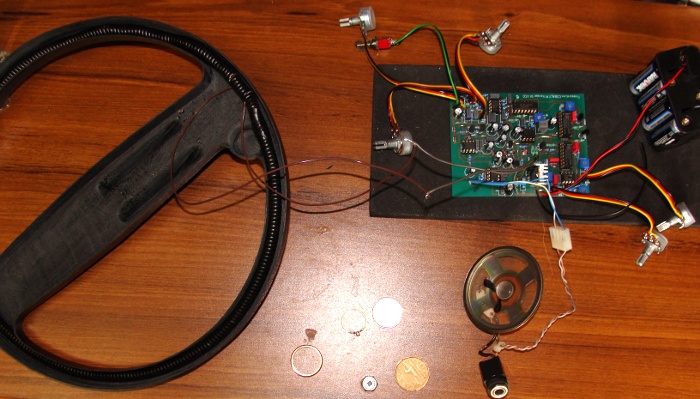
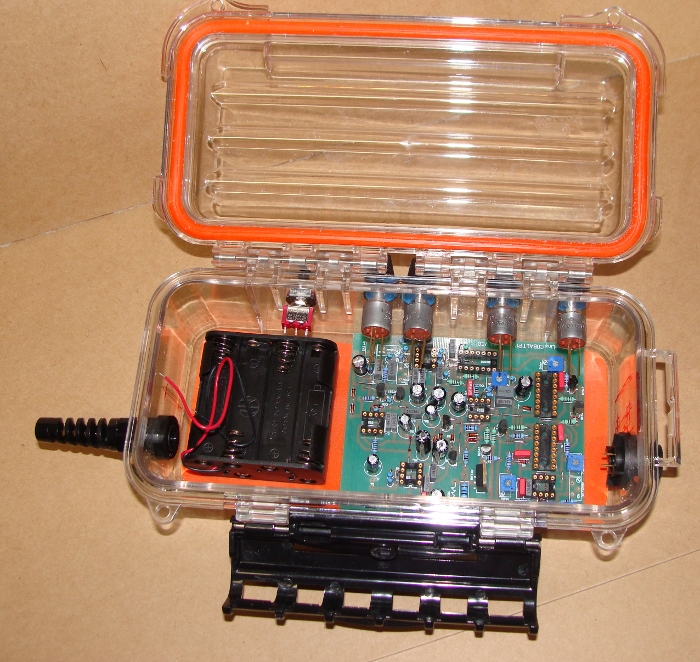

Air test final results:
Last noticeable, faint signal change
Using the 10.5" search coil
Fish scale(1/2 dime)----------9"
Sterling ring---------------------10"
10k ladies ring------------------11"
14kt man's wedding band---14"
Using the 7" search coil
Fish scale(1/2 dime)----------7-8"
Sterling ring----------------------7-8"
10k ladies ring-------------------7-8"
14kt man's wedding band---10-11"
The water unit uses a straight shaft set-up made of parts I had on hand at the time. Detector balances so well that it feels lightweight.
Fisher lower and middle shafts, section of Garrett upper shaft, and a Minelab Sovereign grip-handle. Pictured as well is an attached Tesoro arm rest which has recently been switched out for a Fisher arm rest. The switch was made since the Fisher arm rest has slots to add a arm band across it.
Last noticeable, faint signal change
Using the 10.5" search coil
Fish scale(1/2 dime)----------9"
Sterling ring---------------------10"
10k ladies ring------------------11"
14kt man's wedding band---14"
Using the 7" search coil
Fish scale(1/2 dime)----------7-8"
Sterling ring----------------------7-8"
10k ladies ring-------------------7-8"
14kt man's wedding band---10-11"
The water unit uses a straight shaft set-up made of parts I had on hand at the time. Detector balances so well that it feels lightweight.
Fisher lower and middle shafts, section of Garrett upper shaft, and a Minelab Sovereign grip-handle. Pictured as well is an attached Tesoro arm rest which has recently been switched out for a Fisher arm rest. The switch was made since the Fisher arm rest has slots to add a arm band across it.
Right now the land based was completed. Using a Teknetics Delta lower, middle rods and s-handle set-up. Very comfortable and my custom made control box fits perfectly on top of the s-handle. An electronics project box was used to hold two 4-cell AA battery holders. Which has now been converted holds a 12 volt 4800Mah lithium-ion rechargeable battery. Then simply mounted under the armrest of the s-handle. This set-up makes for better distribution of the detectors weight for a more balanced detector. Next step is to paint the control box and get a faceplate decal made.
I have found the land unit is pure fun to use with the 7" search coil. If I want to cover lots of ground, will put on the 10.5" coil.
I have found the land unit is pure fun to use with the 7" search coil. If I want to cover lots of ground, will put on the 10.5" coil.
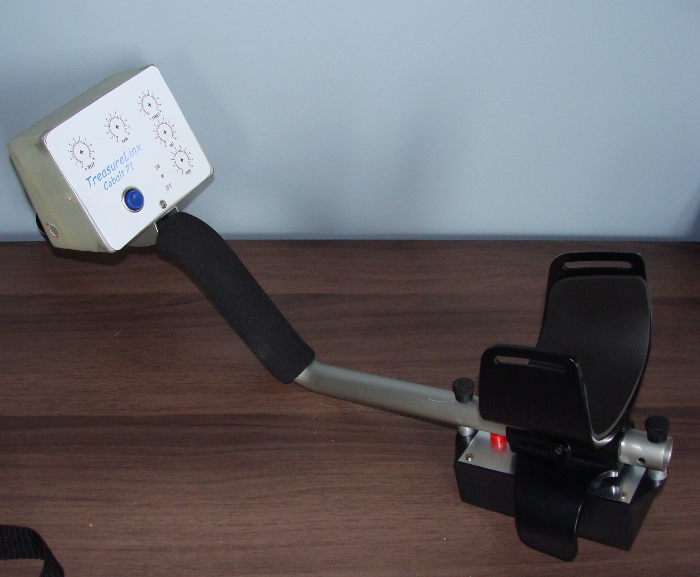
Thought about building your own detector? If you have a developing interest, you should visit the Geotech Website and Forums. Lots of information, schematics, numerous VLF and Pulse PCB's and or kits are available for the hobbyist.
Geotech Website and Forums
Geotech Website and Forums
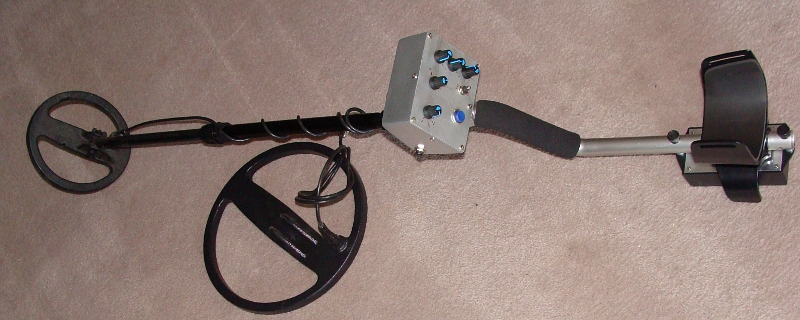
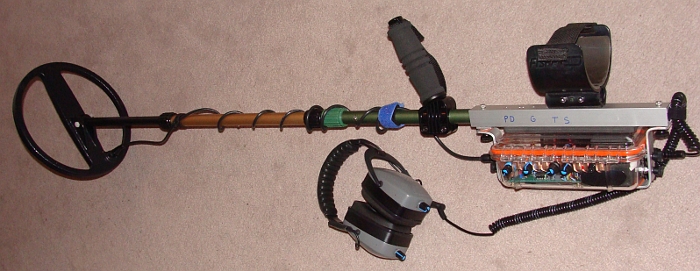
Field Test Info
The water unit performs excellent, first target found was a $2.00 coin. Others joked my first find would be a pull-tab...
I hunted the local freshwater beach. Has no problem getting items deep. Numerous targets deeper than 2', that I just could not dig out. No gold, tough beach to hunt, lot's of other water detectors locally. As well as very deep shifting sands. Need a good storm to dig out some troughs.
The land unit working the dry beach sand is a blast with the 7" coil. Especially when you have the delay set at around 15us, still picks up small gold. But, discriminates out the small foil that normally drive you crazy using a VLF detector. In a very well worked out section, within a couple hours managed to pull out a bunch of coins. I am curious to see how the land unit works at a school yard and park.
Field Test Update Nov 2012
I have been using the PI in many schoolyards with the 7" search coil attached. Was expecting a wild and crazy machine with all the can slaw and junk found in them. Was pleasantly surprised to find it is much more quiet in operation than first thought. It ignores most small trashy foil unlike most VLF in discrimination mode if you want to find small gold rings. Canadian clad coins have a audio distinct sound at the target response peak. Most modern pennies sound like trash so I avoid digging them. Most junk will have a longer muddy sound, coins and jewelry has a short crisp audio signal, have to say pull tabs and bottle caps do as well. Found I can turn up the delay to make the PI less sensitive to can slaw and still find coins, with loss of small gold jewelry detection. Overall, this PI makes an excellent coinshooter in parks and school yards using the 7" search coil. Pinpointing is easy as with any VLF machines using a concentric coil. Lately finding, that I am grabbing the PI machine more than a VLF machine.
Pictured below are two sterling silver chains found the last two months of 2012
The water unit performs excellent, first target found was a $2.00 coin. Others joked my first find would be a pull-tab...
I hunted the local freshwater beach. Has no problem getting items deep. Numerous targets deeper than 2', that I just could not dig out. No gold, tough beach to hunt, lot's of other water detectors locally. As well as very deep shifting sands. Need a good storm to dig out some troughs.
The land unit working the dry beach sand is a blast with the 7" coil. Especially when you have the delay set at around 15us, still picks up small gold. But, discriminates out the small foil that normally drive you crazy using a VLF detector. In a very well worked out section, within a couple hours managed to pull out a bunch of coins. I am curious to see how the land unit works at a school yard and park.
Field Test Update Nov 2012
I have been using the PI in many schoolyards with the 7" search coil attached. Was expecting a wild and crazy machine with all the can slaw and junk found in them. Was pleasantly surprised to find it is much more quiet in operation than first thought. It ignores most small trashy foil unlike most VLF in discrimination mode if you want to find small gold rings. Canadian clad coins have a audio distinct sound at the target response peak. Most modern pennies sound like trash so I avoid digging them. Most junk will have a longer muddy sound, coins and jewelry has a short crisp audio signal, have to say pull tabs and bottle caps do as well. Found I can turn up the delay to make the PI less sensitive to can slaw and still find coins, with loss of small gold jewelry detection. Overall, this PI makes an excellent coinshooter in parks and school yards using the 7" search coil. Pinpointing is easy as with any VLF machines using a concentric coil. Lately finding, that I am grabbing the PI machine more than a VLF machine.
Pictured below are two sterling silver chains found the last two months of 2012
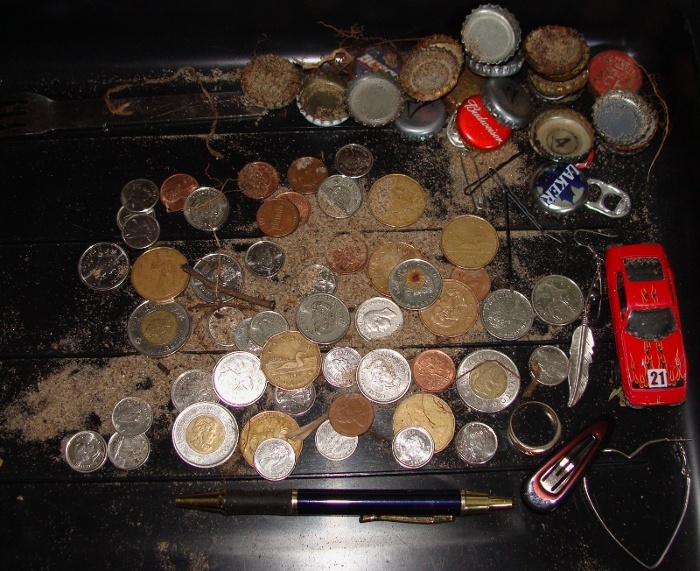
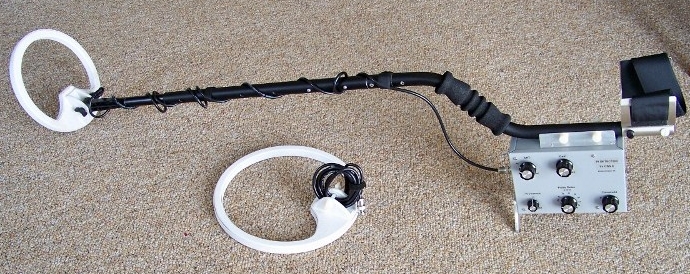
For those that are interested, my PI is based on Carl Morelands Hammerhead PI that was re-engineered by a friend that goes by the name Smitty II. It is designed to be more sensitive to smaller gold and jewelry. I took the schematics and had PCB's made. A number of PCB's were shipped to Smitty to build up. Overall, this project was a success. More coming down the pike....... Pictured below is Smitty's build.
New Build For 2013
Just finished up the last remaining PCB of the original boards made. Some different higher end components were used, mainly to see if it would make a difference in performance. The completed and calibrated board went into a new metal control box. To help block out any EMI. It is also compact that fits in the palm of your hand. All new metal battery box that rest under the armrest was made as well. It holds a 3000 mah rechargeable lithium-ion battery. New search coils were constructed used a high marine grade U/V resistant coaxial cable and then covered with a protective braided shield.
Having some more PCB's made as I would like to build several more land units and water units.
New Build For 2013
Just finished up the last remaining PCB of the original boards made. Some different higher end components were used, mainly to see if it would make a difference in performance. The completed and calibrated board went into a new metal control box. To help block out any EMI. It is also compact that fits in the palm of your hand. All new metal battery box that rest under the armrest was made as well. It holds a 3000 mah rechargeable lithium-ion battery. New search coils were constructed used a high marine grade U/V resistant coaxial cable and then covered with a protective braided shield.
Having some more PCB's made as I would like to build several more land units and water units.
